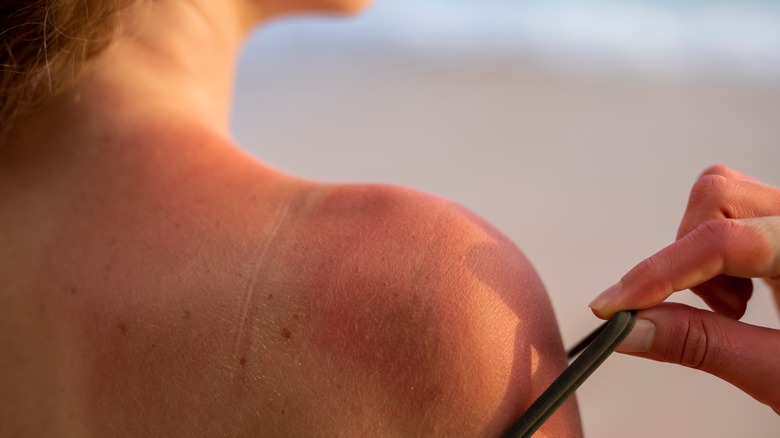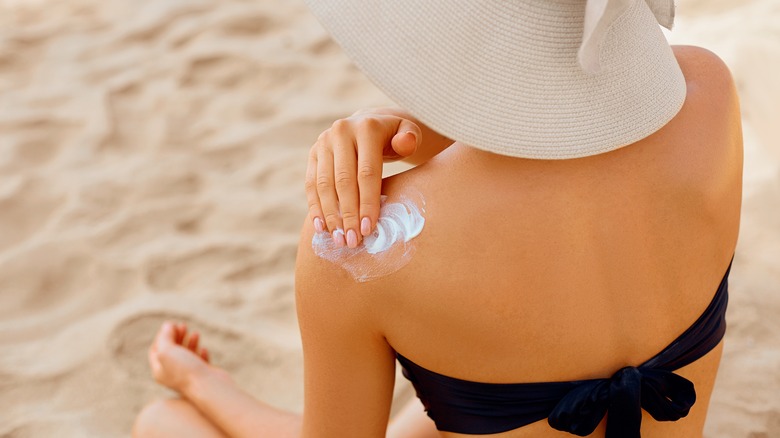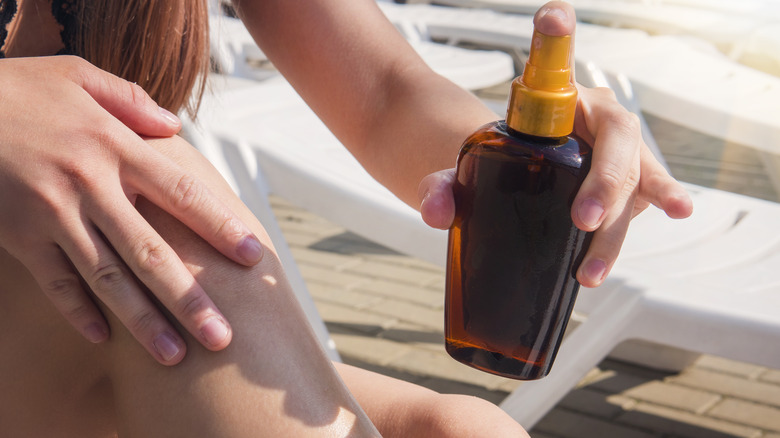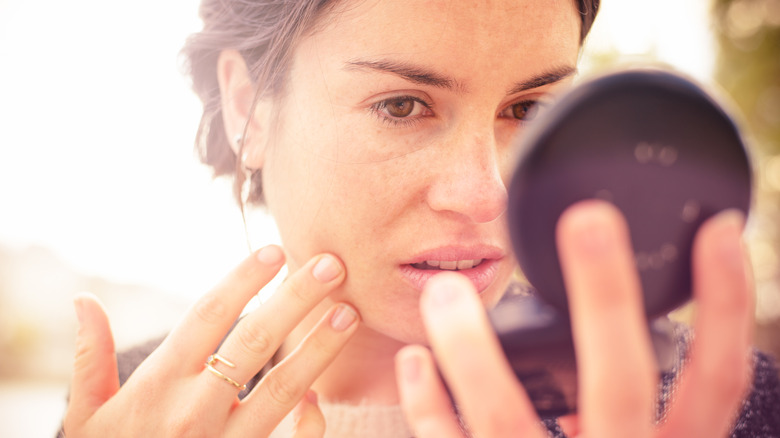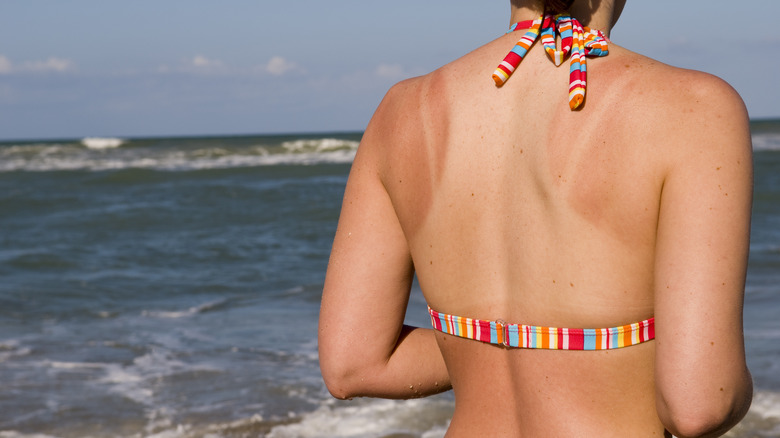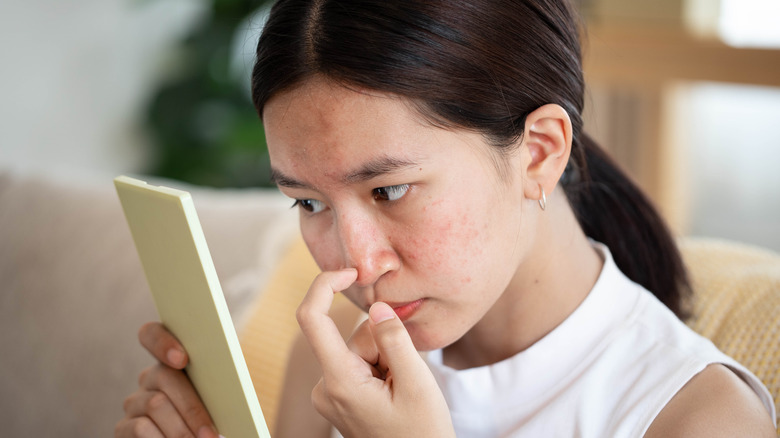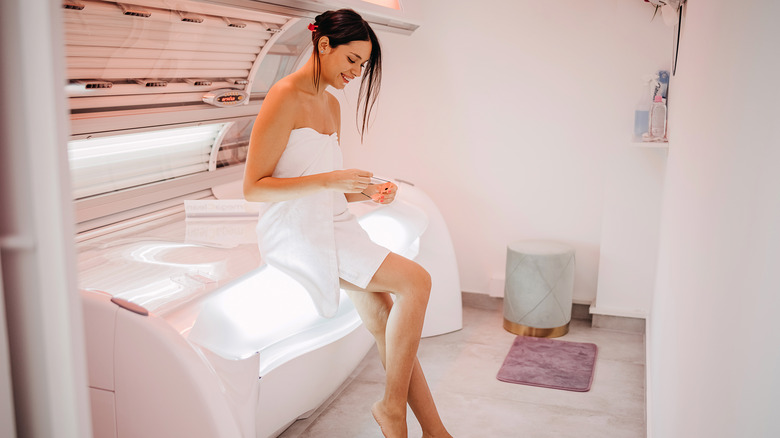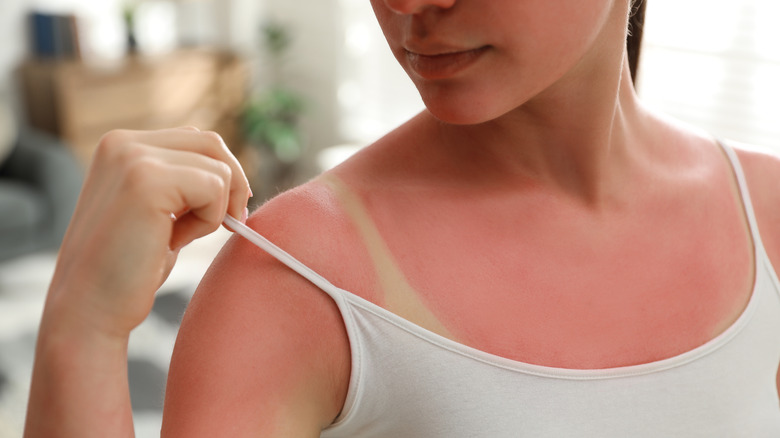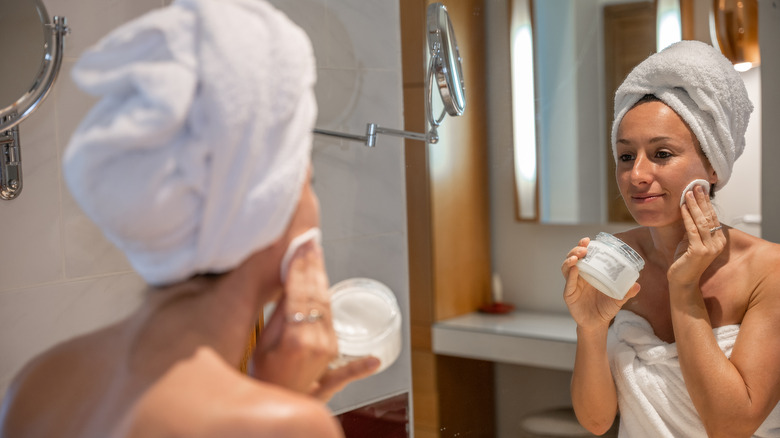Tanning Myths We Need To Leave In The Past
Tanning, at least in the West, has been in vogue since the Roaring '20s when Coco Chanel first popularized the idea of sun-kissed skin as a symbol of leisure and health. Of course, our understanding of skin and sun exposure has come a long way since then. But the trend still remains an accepted and fashionable practice even in our modern era. What's more, all these years later, myths and misconceptions about tanning continue to linger. And those myths and misconceptions can have a harmful effect on consumers and public health.
A 2019 investigation published by the Journal of Preventive Medicine Reports highlights just how deep some of these impressions run. There are people who still believe sunscreen doesn't have to be applied regularly. There are others who still believe that as long as you don't burn, tanning is safe. And there are those who still don't make a point of practicing sun protection strategies. We hope to dispel some of these old tanning myths and dig into why we should leave them behind.
How does tanning affect the body?
Tanning is the result of exposure to ultraviolet (UV) radiation. According to the AT Melanoma Foundation, UV rays are divided into A, B, and C. UVA has the longest wavelength, is the one we're most exposed to, and is the one that penetrates the skin the most. Conversely, we're exposed to only a small amount of UVB and almost no UVC because they're more easily absorbed by the earth's atmosphere.
When UV does hit us, however, it has a mutagenic effect, meaning UV changes how components of the skin and body are structured or function. One example of this is tanning. As the Journal of Current Oncology explains, tanning happens when UVA hits the deepest part of the skin's epidermis, the basal layer. The radiation causes the production of the pigment melanin, which makes the skin darker and offers some defense against further sun damage.
Another effect is sunburn caused by UVB. UVB can't go as deep as UVA, but since it's shorter, it has more energy. As it hits the epidermis, the skin's blood vessels expand, causing redness and inflammation, known as erythema (or sunburn). But perhaps, lesser known is that the damage of UV doesn't stop there. The National Institute of Health warns not only does it mutate how cells function, but DNA, which, as we'll discuss, plays a role in premature skin aging, and, unfortunately, cancer.
Myth: As long as you're wearing SPF, tanning is safe
As dermatologist slash YouTuber Dr. Dray emphasizes, a tan is simply a reaction to skin injury. And the more you injure your skin, the more you accumulate damage, increasing the likelihood of skin disease. Although SPF mitigates some of this risk, protection isn't automatically guaranteed. Exercise, sweating, and swimming cause sunscreen to wash off faster, reducing protection. Moreover, unless a sunscreen is labeled "broad spectrum," it only protects against UVB, meaning you'll still be getting damage from UVA.
This is because SPF isn't actually a measure of how long you can stay in the sun or how effective sunscreen is. Rather, the FDA explains SPF only measures how much UV radiation is needed to burn unprotected skin. While the higher the SPF, the more protection against sunburn, it's only a measure of how much protection you'd get relative to unprotected skin.
For instance, an SPF of 15 means you'd get 15 times more protection than someone without. However, if the sun intensity is high, you have fair skin, or you don't reapply your SPF, tanning with SPF won't particularly matter, you're still getting exposed to sun radiation, just less of it. Even the highest SPF factor, SPF100, can only prevent 99% of UV. Comparatively, if you're wearing SPF 30, at least 3% of the sun rays will be hitting your skin. In other words, you're always getting hit by UV rays, sunscreen doesn't stop this altogether.
Myth: Tanning oils help you get a tan without getting burnt
The main component of tanning oils designed to enhance the appearance or speed up the process of tanning is mineral oil. Mineral oils, specifically the kind used in cosmetics, are non-reactive types of purified petroleum derivatives (or polycyclic aromatic hydrocarbons). According to a 2019 article published in the Journal of the European Academy of Dermatology and Venereology, these compounds are highly stable and have protective qualities for the skin's barrier, preventing water loss, but don't typically penetrate the skin.
According to a 2012 review in the International Journal of Cosmetic Sciences, mineral oil helps with tanning because it has a refractive quality close to the skin itself. This means it allows more light (UV) to penetrate the skin than it reflects, which can accelerate the process of melanin generation, creating a tan.
However, unless a tanning oil explicitly says it contains some kind of sun filtering ingredient or has an SPF factor, the main component, mineral oil, can't stop the damage of UV once it's entered the skin. To some extent, it might help manage side effects like water loss, which can trigger premature aging, but it also makes the skin slightly more sensitive to the sun overall. In short, it's not much of a match against the sun's harsh rays.
Myth: Sunscreen stops you from getting a tan
While sunscreen may minimize the amount of sun radiation, it does not grant immunity. As the American Academy of Dermatology put it, "sunscreen alone cannot fully protect you." Therefore the idea that sunscreen prevents tanning is likely erroneous. Sunscreen is just a filter. What you'll typically see on your sunscreen label or list of ingredients will be either a physical type of filter, like zinc oxide or titanium oxide, or a chemical type, like oxybenzone.
These ingredients can essentially act as a barrier to the sun or help to absorb and dissipate radiation. However, as the American Cancer Society points out, factors including the sun's intensity, the time of year, and the amount of cloud coverage can drastically impact how successfully these sunscreens can shield you. For instance, a person out under the midday sun, compared to one in the early morning sunlight, will get far more UV exposure than the latter.
So yes, as long as you're getting hit by UV, you'll get a tan. But you're also putting yourself at risk of irreversible damage. According to a 2019 article in Nature Reviews Immunology, research now shows that UV can have an effect on the immune system, causing multiple and seemingly unrelated issues to the way our body's defense system functions. For instance, damage to keratinocytes, the main components of the skin's barrier, sets off a chain reaction that causes oxidation, breaking down important skin cell tissue structures, and even causing cell death.
Myth: Base tanning builds resistance to sunburn
A base tan is the idea of getting a low-level tan before you expose yourself to more intense sun. The premise is that if you have a base tan, you'll be less likely to burn later. While melanin does indeed protect the skin from UV rays to some degree, it is not an impenetrable shield.
So, if you plan on getting a base tan to increase melanin before heavy sun exposure, you may want to reconsider. Even if your skin doesn't burn, it is still susceptible to sun damage. According to a 2015 article published in Harvard Health Publishing, a base tan provides an SPF level of three or four. While that's certainly more than unprotected skin, it's essentially like wearing tanning oil. So, you'll still be exposed to a decent amount of UV radiation, not to mention whatever exposure you've gotten from forming the base tan in the first place. As Dr. Dray further explained on YouTube, sun tanning not only doesn't offer adequate sun protection, but the previous damage caused by the base tan can actually slow wound healing during later tanning sessions.
Myth: Tanning clears acne and other skin issues
While acne development has many different causes, research shows that UV can play a role in its formation. Per Water's Edge Dermatology, sun exposure can increase oil production, which can lead to clogged pores and inflammation. These conditions affect the skin's microbiome (the good and bad bacteria on our skin), potentially contributing to a climate conducive to acne.
Despite this, some people may believe that artificial tanning beds are a safe alternative to help with skin conditions such as eczema or psoriasis. While certain light therapies may help with these conditions, the unsupervised use of sunbeds isn't recommended. Tanning salons will unlikely have the right knowledge to provide the correct UV strength, intensity, or consistency needed for safe and effective treatment.
And the evidence for sunbeds as an effective acne-fighting solution is even less convincing. As noted in the Journal of Clinical and Experimental Dermatology, some studies indicate that while blue light therapy is sometimes offered as an acne treatment, sun tanning beds aren't a good substitution. Not only are they likely to exacerbate acne, but many acne patients are concurrently on retinol, meaning sunbeds can cause an adverse reaction due to photosensitivity. This is because light therapy, unlike sunbeds, doesn't involve UV exposure; rather, it's a different type of light in the visible spectrum.
Myth: Sunbeds are better than sunbathing
Unfortunately, there are just as many cancer risks involved in sunbed use as in outdoor sunbathing. A study in the Journal of Cancers highlights that skin cancers such as melanoma, skin carcinoma, and basal skin carcinoma are highly associated with its use. Moreover, their research found that the earlier one used sunbeds and the more frequently they used them, the higher this risk was. For instance, the risk of melanoma for those using a sunbed ten times or more in a year was 52% higher than for people who didn't.
Essentially, indoor tanning or sunbeds are an artificial source of UV radiation designed to mimic sun exposure and develop a tan. However, there are several issues with this practice. Firstly, UV radiation of any kind causes skin damage. However, due to the idea that these beds are a safe alternative to sunbathing outdoors, users can actually put themselves at risk of longer and more intensive exposure than they would get sunbathing. As noted in an article for the Journal of Current Oncology, sunbeds have been classified as a human carcinogen –that is, they cause cancer in humans.
In other words, as the American Academy of Dermatology explains, whether you tan outside or inside, the risk and effects are essentially the same. Moreover, most tanning beds only emit UVA, which means your body won't get any benefits like vitamin D, which comes from UVB.
Myth: Sunburns always become tans
A tan occurs when UVA stimulates the production of melanin in our skin. Conversely, a sunburn occurs due to erythema (redness and inflammation caused by skin injury) as a result of UVB exposure. Both are injurious, but are somewhat different kinds of injury. And as for whether or not a person can tan in the first place? Well, that has to do with skin type. As dermatologist Dr. Dray explained in a YouTube video, "[Tanning] actually requires a threshold of UV exposure. For people with pale skin, they can't reach that threshold without burning. ... But for people with deeper skin tones, they definitely can easily tan."
Melanin not only protects the skin from UV, but redistributes it — and that's what creates a tan. However, if a person with pale skin has a sunburn, there isn't enough melanin to protect and redistribute the UV to turn it into a tan. And in that case, the burn will stay a burn until it fades entirely.
Interestingly though, while sunburns won't always become a tan, the reverse may be true. Although melanin may protect the skin to a certain degree, things that speed up the tanning process, such as oils, can cause the skin to burn more easily, along with an increase in the risk of cancer and premature aging.
Myth: Coconut oil is a safe way to tan faster
According to a 2019 article in the Journal of Health Communication, in recent years, there's been an increase in homemade tanning and sunscreen formulas with the use of coconut oil appearing on social media. While these recipes promise the same safety as traditional sunscreens, there are only 17 approved active sunscreen ingredients in the United States (only three with both UVA and UVB protection), and coconut oil is not one of them.
While natural products like coconut oil may have some prUV protective properties, the actual SPF numbers for such ingredients is not enough to prevent sun damage. In fact, coconut oil only has an SPF value of four. And the vast majority of so-called natural-based tanning products or sunscreens tend to fall into this same category.
Now, about that UV protection. A 2016 study published in the International Journal of Cosmetic Science found that coconut oil — as well as fellow natural oils like canola and citronella — falls rather short when it comes to actually blocking UV rays. The conclusion? If you want to help your skin put up a decent fight against the sun, put the homemade concoctions away and stick with commercial sunscreens that feature SPF and UV blocking ingredients.
Myth: It's impossible to get vitamin D while wearing sunscreen
The common belief that sun tanning has health benefits likely comes from the fact that UV can help stimulate the body to produce vitamin D, which plays a role in regulating bone and muscle health. However, as noted investigative report from the U.S. House of Representatives Committee on Energy and Commerce, the general consensus in the science world is that the risks and negative effects of UV far outweigh any of these benefits — particularly since UV exposure can be easily substituted by vitamin supplements, which are safer and more effective means of getting vitamin D.
Due to such misconceptions surrounding tanning as a healthy practice, it's probably no surprise then that many believe that sunscreen is somehow detrimental to this search for vitamin D. As previously noted, sunscreen filters UV. Therefore, you might assume that if you're wearing a lot of sunscreen, it'll reduce the amount of vitamin D you're getting. This is also incorrect.
According to an article in the British Journal of Dermatology, studies looking at how the human body synthesizes vitamin D whilst wearing sunscreen have found that people who applied a high level of UVA protection were able to synthesize the same, if not more, vitamin D than those with lower protection. This illustrates that you can still get vitamin D even whilst practicing safe sun habits.
Myth: Fake tans aren't safe
Fake tans — and we're talking the topical kind containing dihydroxyacetone (DHA) — have raised some questions regarding health and safety. As Consumer Reports notes, there have been concerns about whether or not DHA ages the skin. However, as Dr. Michelle Wong explained to the site, "The human studies so far have found that DHA mostly reacts in the top layers of the skin, which are dead. In skin aging, the concern is excessive free radicals forming deeper in the dermal layers of skin where collagen and elastin are." According to the FDA, DHA is fine for skin, but shouldn't be inhaled or ingested.
DHA is actually a form of sugar derived from the fermentation of naturally occurring alcohol. According to Dr. Dray, DHA works by triggering the synthesis of a chemically similar pigment to melanin, giving the skin a natural-looking tanning effect. Practically speaking, DHA has undergone extensive testing to ensure its safety. Although sensitivity is possible, it's rare, and you can use it with sunscreen. And unlike a suntan, a fake tan doesn't involve harsh UV rays.
While a fake tan doesn't last as long, sun exposure actually increases the skin's turnover time. According to research featured in the Textbook of Aging Skin, the total epidermal turnover time — that is, how long it takes to shed that top layer and renew itself with new, healthy cells — is slower in UV-exposed skin. Fake tans stick around for about a week, whereas UV tans can last 11 to 15 days.

